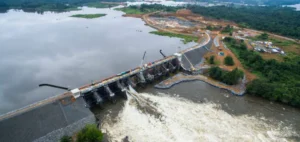Sun’R officially announces the acquisition of the Grépiac hydroelectric plant, located in the Haute-Garonne department. This operation allows Sun’R and the Eiffage Group to own a fleet of 15 plants with a combined production capacity of 40 GWh.
The announcement of this acquisition was made in December 2022, as part of the merger between Eiffage and Sun’R. The objective was to create new synergies in favor of the environment and to make Sun’R the group’s renewable energy development platform.
A new entity for hydroelectricity at Sun’R: Sun’Hydro
With the acquisition of the Grépiac power plant, Sun’R officially launches its hydroelectric energy production activity through a dedicated entity: Sun’Hydro. This plant complements the existing network of 14 other Sun’Hydro plants, which was established as part of its initial development within Eiffage. With these 15 plants in the southwest and the Rhône-Alpes region, Sun’Hydro is initiating a strategy of acquiring and modernizing small and medium-sized infrastructures, taking into account the new climatic challenges and the need for rational long-term water management.
Built in 1986 on the Ariège River, the Grépiac power plant was completely renovated in 2022, doubling its annual production to 6 GWh, equivalent to the electricity consumption of 1,000 inhabitants. This production corresponds to the total population of the city of Grepiac. The power plant has two latest generation DIVE units, with a nominal head of 3.77 m and an equipment flow rate of 44 m3/s. Maintenance of the installation will be carried out by Eiffage Energie Systèmes’ teams.
Sun’R continues its green commitment
In 2022, the French group Sun’R was integrated into the Eiffage Group and became its platform for the development of renewable energies such as photovoltaic, agrivoltaic, hydroelectric and green energy supply. Sun’R was created in 2007 to contribute to the ecological transition by specializing in renewable energies and works on the entire value creation chain of these energies.
Its subsidiary Sun’R Power has a solar park of 100 MWp in operation and another 700 in development, thanks to the group’s historical expertise in photovoltaic engineering. Sun’Hydro is another subsidiary specializing in hydroelectric production. By the end of 2023, this subsidiary will have a production capacity of nearly 40 GWh (17 GWh in 2022) through the management of 15 power plants. Finally, Sun’Agri, a pioneer in agrivoltaics, designs and implements intelligent solutions for adapting agriculture to climate change, with 220 hectares protected or under study, equivalent to an output of approximately 150 MWp.






















